Just a short drive from the historic university city of Coimbra is one of Portugal’s most fascinating archaeological treasures. The ancient Roman city of Conimbriga is hidden amid rolling hills and quiet countryside. Visitors can step back nearly two thousand years and explore the remnants of a once-thriving settlement. I was amazed by the sheer size of the Roman ruins, from incredibly well preserved mosaic floors to the foundations of grand villas and public baths. With a museum on site, a visit to Conimbriga provides unique insight into the the workings of this prosperous community. Enjoy our guide to taking a day trip to the Conimbriga Roman Ruins Portugal, ideal for travelers interested in history and architecture.
This post may contain affiliate links. If you make a purchase through these links, we will earn a small commission at no additional cost to you. We recommend products we have personally used or verified. Read the full disclosure here.
Save this post for later!
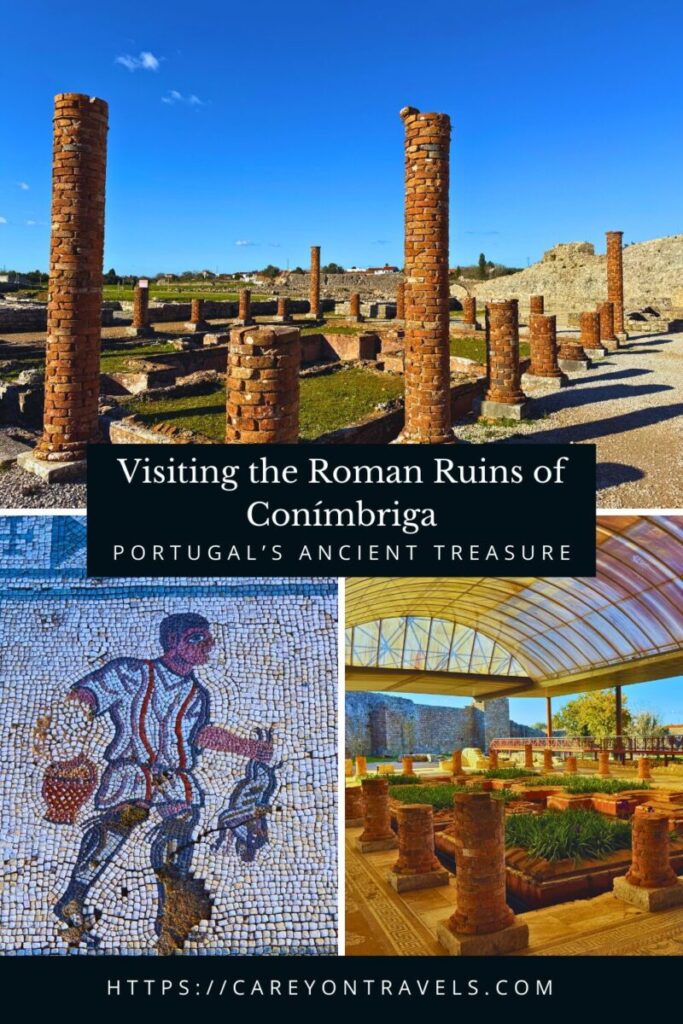
History of Conimbriga Roman Ruins Portugal
Conímbriga was one of the largest and most important Roman settlements in Portugal, at its peak from the 1st century BCE through the 4th century CE. Originally a Celtic settlement, it was integrated into the Roman Empire after the Roman conquest of the Iberian Peninsula in the 2nd century BCE. Conímbriga flourished as a wealthy town with public baths, a forum, an extensive water system, and expansive residences.
It maintained a strategic location along the Roman road between Olisipo (now Lisbon) and Bracara Augusta (now Braga). During the 5th century, the town was attacked by the Suebi, a Germanic tribe. Many inhabitants fled to nearby Coimbra, and although Conímbriga was never completely abandoned, it gradually declined in importance. Today, its remarkably well-preserved ruins offer one of the most vivid windows into daily life in Roman Lusitania.
How to Get from Coimbra to Conímbriga
Here’s how to get from Coimbra to Conimbriga (roughly 17.3 kilometers (10.7 miles):
- By Taxi or Ride-Sharing Services: A direct taxi ride, Uber, or Bolt takes about 16 minutes and costs between €14–17.
- By Bus: Transdev operates buses from Coimbra to Conímbriga, though they only run a few times a day (check website for schedule details). The journey takes approximately 45 minutes, with tickets costing under €3 each way.
- By E-Bike: consider renting e-bikes in Coimbra, and ride the 35 km round trip route. While there are some hills leaving Coimbra, the e-bikes can assist with this. A tour, which includes rental e-bikes, directions, and tickets, is also available.
- On Foot: The ruins are just off of the Portuguese Camino route. For those who are waking or biking this route, there are bathrooms and water refill stations available to the public, as well as a nice picnic area (without having to pay entry fees).
While most visit on a day trip, consider visiting as part of a Lisbon to Coimbra Road Trip.
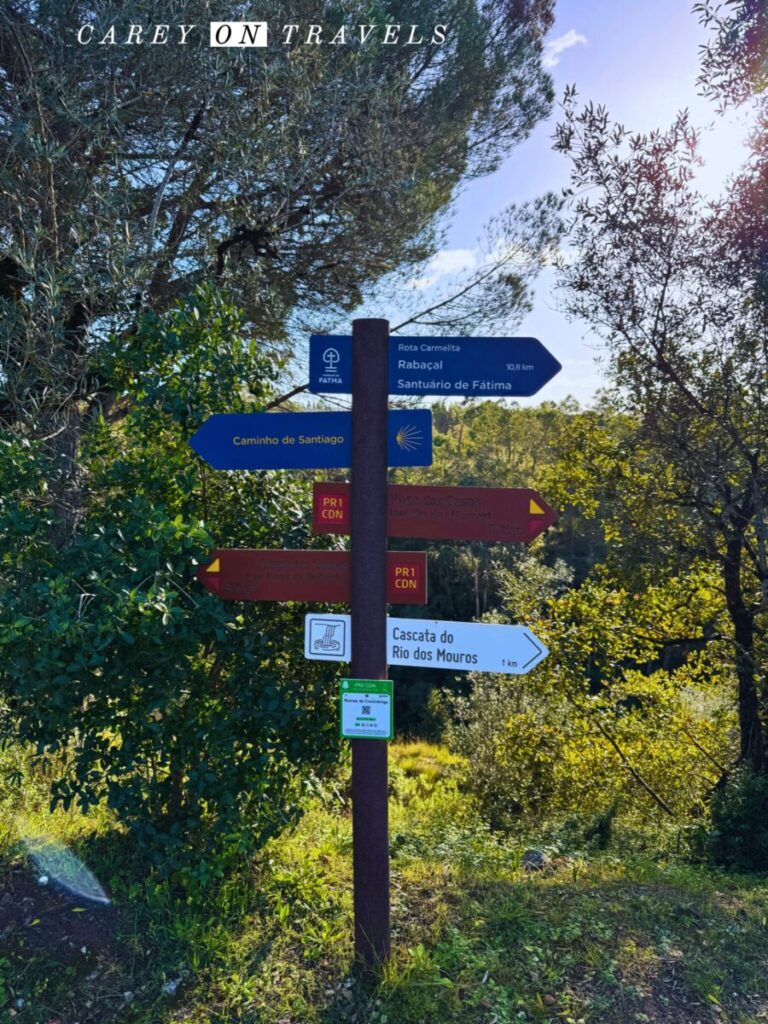
Top Tours to Enhance Your Conimbriga Visit
To fully appreciate Conímbriga’s historical significance, consider joining a guided tour:
- Conímbriga and The Roman Tour: This private 4 hour tour includes visits to the ruins, the aqueduct’s source, the Monographic museum on site, and the Portugal Roman Museum in Sicó. As a bonus, it offers pickup and drop-off in Coimbra. Explore the ruins and museum with a knowledgeable guide who will provide in-depth insights into the site’s history and architecture.
- Conímbriga with Hiking Tour: Explore Conimbriga and the museum for an hour, then head off on a waterfall hike to Cascata Do Rio De Mouros (waterfalls).
- E-Bike Tour from Coimbra to Conimbriga: This Tour includes bike rentals and guidance, as well as tickets to get in to the Conimbriga Roman Ruins.
What to See at Conimbriga Roman Ruins Portugal
Visiting the Conímbriga Roman ruins offers a profound glimpse into Portugal’s ancient past. To make the most of your visit, we’d suggest the following itinerary:
Conimbriga Roman Ruins Admission Costs and Options
The latest combined admission fee for both the museum and the archaeological site is €10 per person. Visiting hours are Monday to Sunday 10 am – 6 pm, with the ticket office closing at 5:15 pm. We recommend checking the official website or contact the site directly for the most current information on ticket prices and visiting hours.
1. Begin at the Monographic Museum of Conímbriga
Start your exploration at the Monographic Museum, located adjacent to the ruins. The museum houses an extensive collection of artifacts unearthed from the site, including intricate mosaics, statues, coins, and everyday items that provide insight into Roman life. Visiting the museum first provides valuable context for the structures you’ll encounter in the archaeological site, especially if you are visiting without a tour.
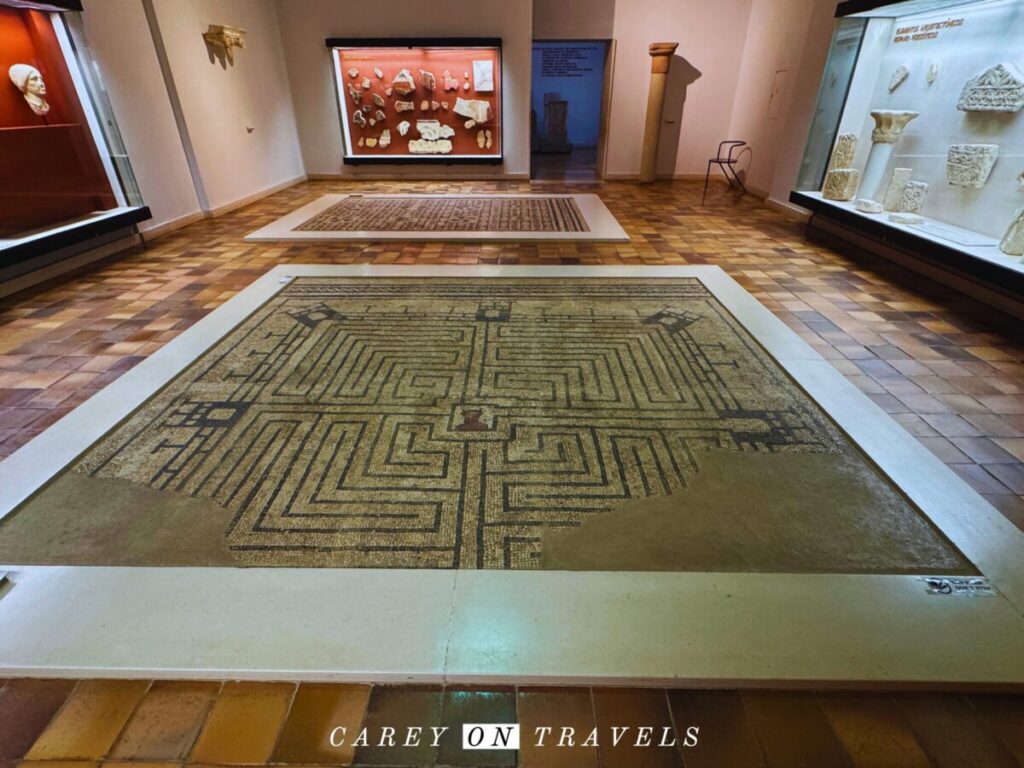
After gaining background knowledge from the museum, proceed to the ruins to explore the remnants of Roman architecture and urban planning:
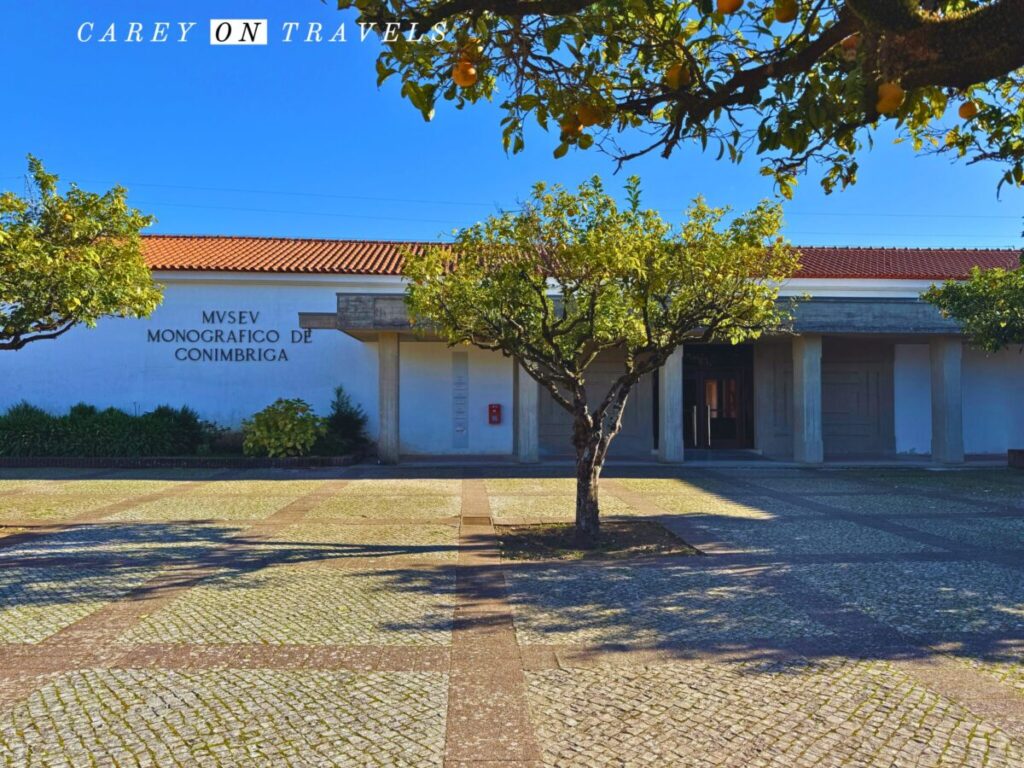
2. Mosaics
As you tour the museum and site, keep an eye out for the beautiful mosaics. The level of detail and preservation of these mosaics is incredible.
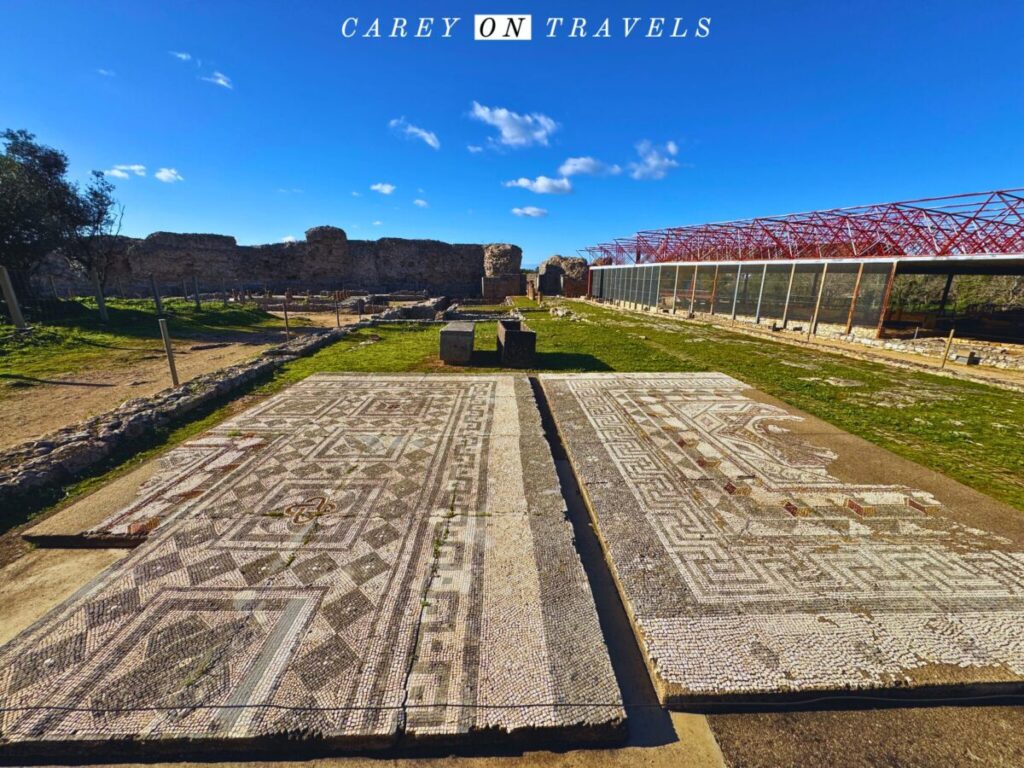
3. House of Fountains (Casa dos Repuxos)
This grand residence, constructed around 200 CE, features a central courtyard adorned with functioning fountains and vibrant mosaics. The protective roofing ensures the preservation of these mosaics. While you can’t walk around all areas of this residence, I still found this to be one of the most interesting to visit, with its extensive mosaics.
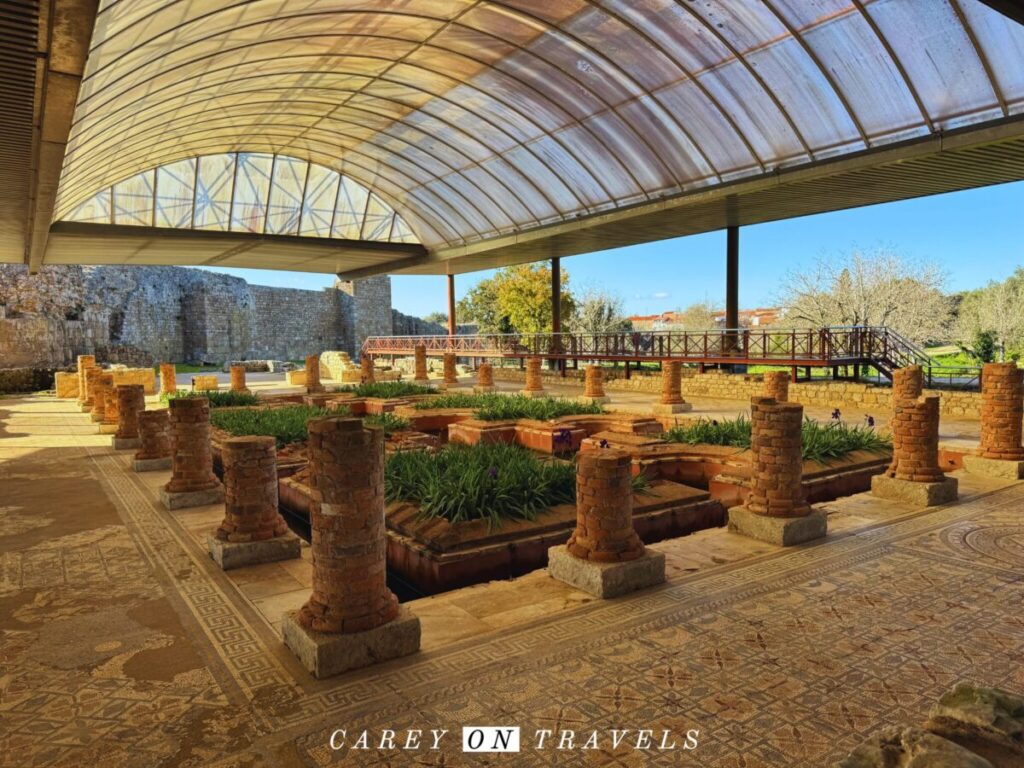
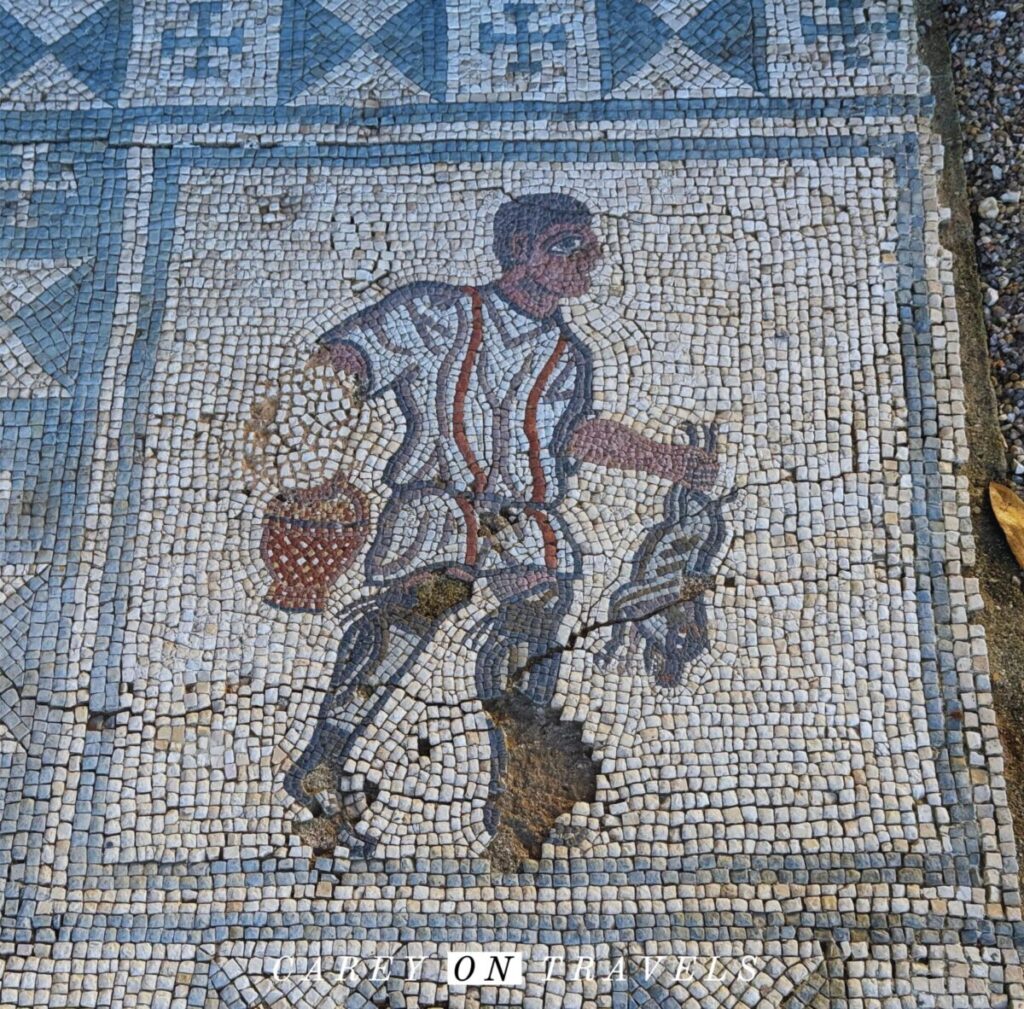
4. House of Cantaber
One of the largest and most complex homes unearthed at Conímbriga, the House of Cantaber likely belonged Cantaber, the city’s top aristocrat in the 5th century. It boasted over 40 rooms, private baths, and a sophisticated heating system. When Conimbriga was invaded by the Suebi in the 5th century, Cantaber was murdered in his own home, and his wife and children sold into slavery.
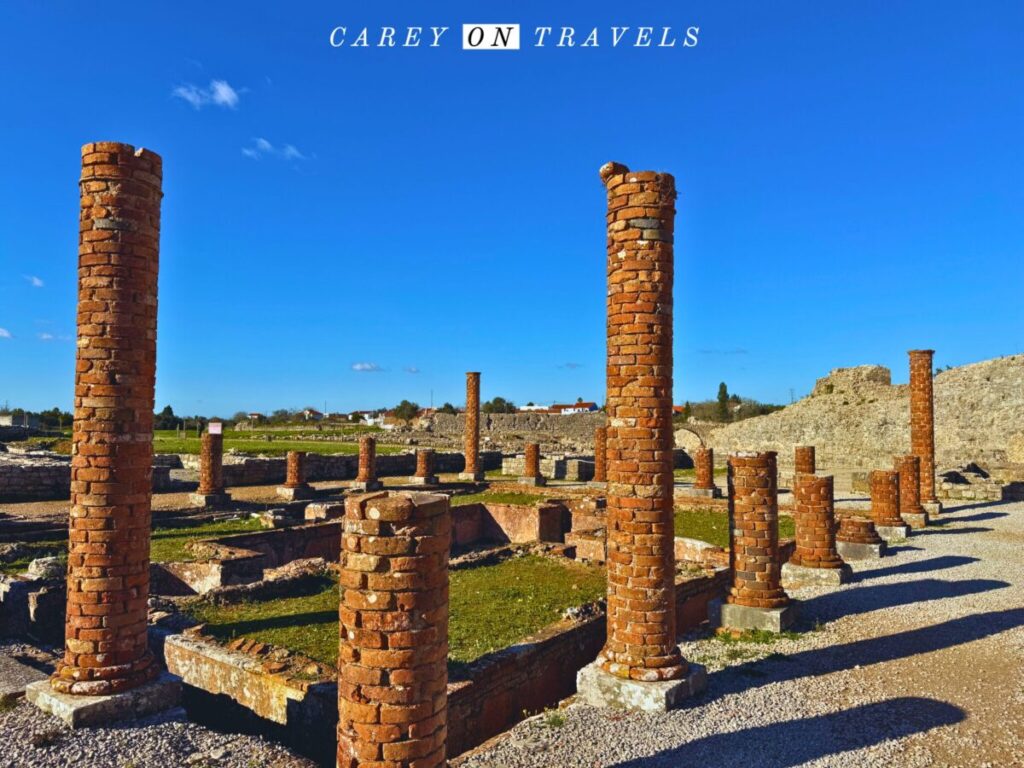
5. House of Swastikas (Casa da Cruz Suástica)
This house is named for the swastika motifs embedded in its mosaic floors. The Romans saw this motif as a symbol of good fortune. Here you can admire the intricate designs indicative of the era’s artistic craftsmanship.
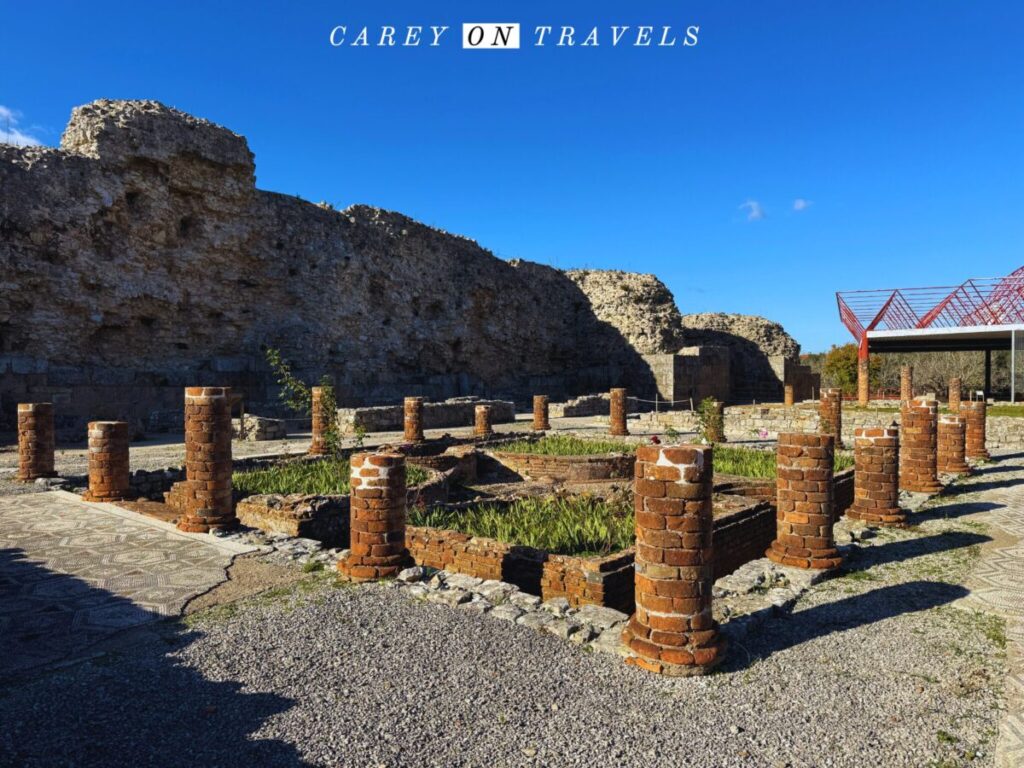
6. House of Skeletons
This smaller residence gets its name from the discovery of human remains during excavation. Some people think that they may have been residents caught in the chaos of the Suebi invasion in the 5th century.

7. Public Baths
The public baths showcase the Romans’ advanced engineering. The extensive bath complex had both cold and hot rooms, changing areas, and a hypocaust system that provided radiant heating. Don’t miss a look under the baths to see the remnants of pre-Roman era indigenous homes.
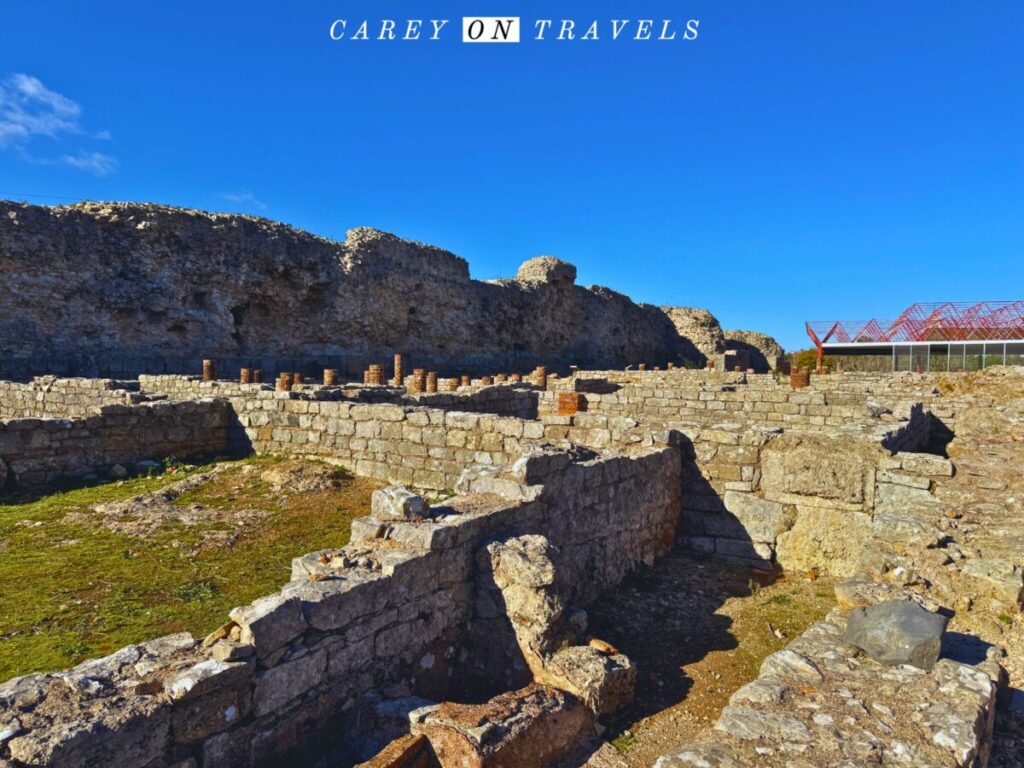
8. The Forum
The public forum at Conímbriga served as the political, commercial, and social heart of the city. This central square was surrounded by important administrative buildings, a basilica, and shops, where citizens gathered for everything from civic meetings to market transactions.
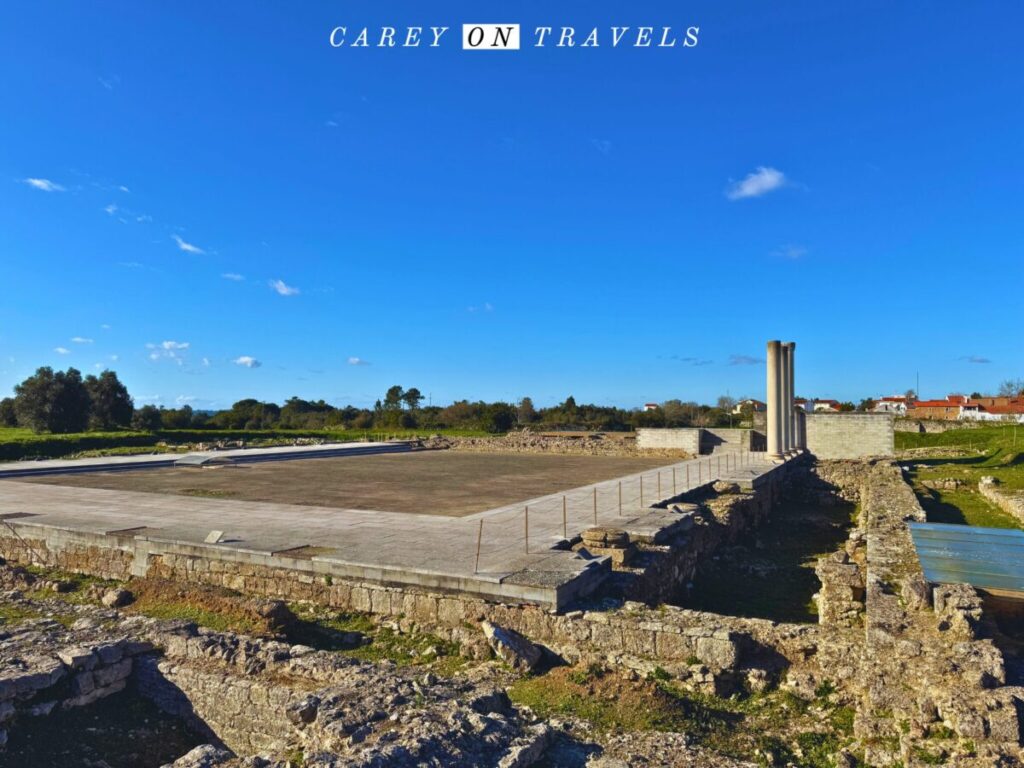
Although much of the original structure has been lost, the layout remains visible. You can visit a replica in the museum, which provides insight into how Roman towns were organized. This included communal spaces that blended governance, commerce, and daily life.
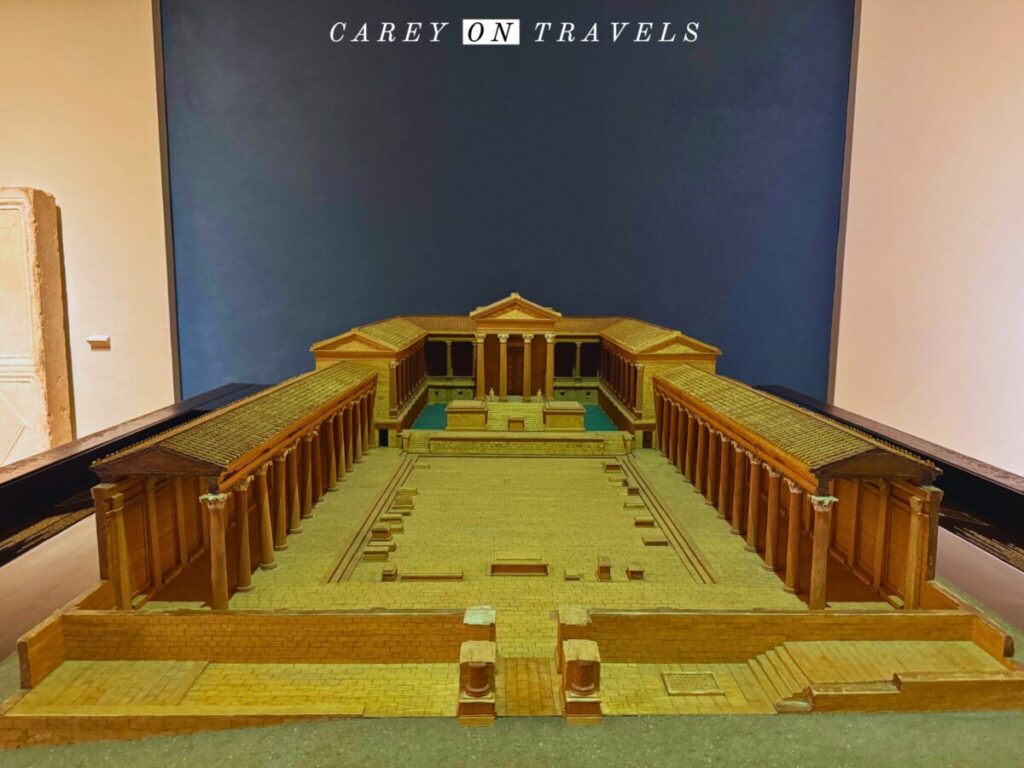
9. Visit the Aqueduct at Alcabideque
Wrap up your tour of Conimbriga by visiting the remains of the Roman aqueduct located in Alcabideque. It is approximately 3.5 kilometers from Conímbriga, and is best reached by car (many tours include this stop as well). This aqueduct was engineered to transport water from a spring to the city. This is a testament to the Romans’ ingenuity in urban planning. The original collecting basin of the spring water is still visible and serves as the local village pond.
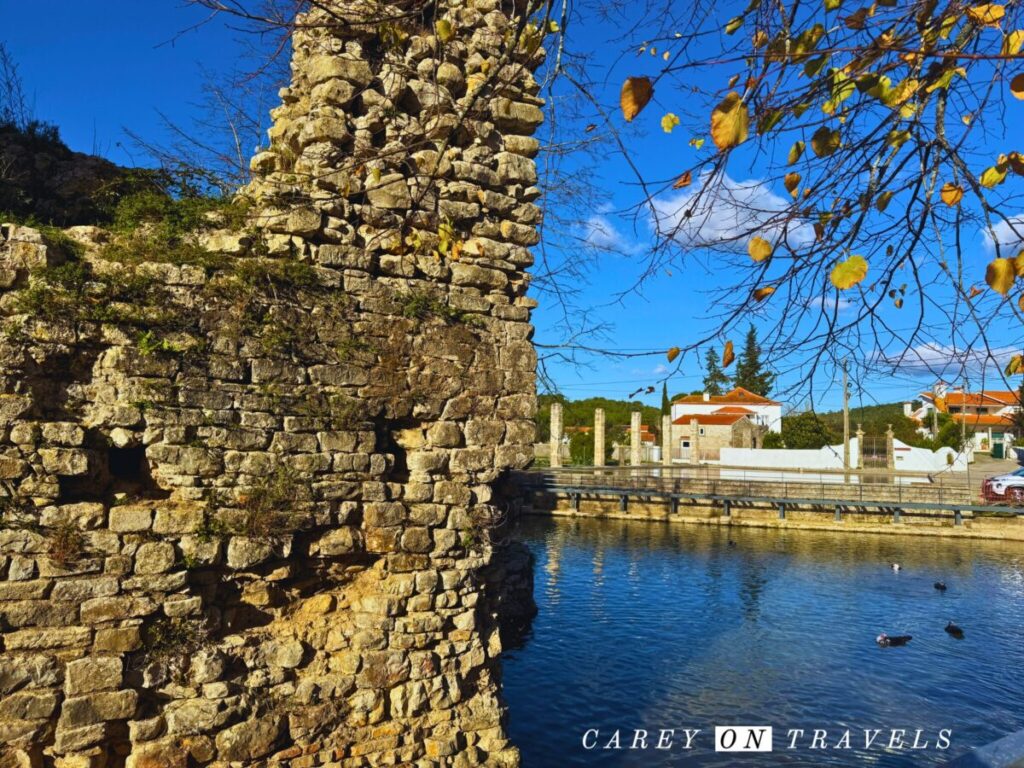
Final Thoughts on a Visit to Conimbriga Roman Ruins Portugal
A visit to Conímbriga is a chance to walk through a former prosperous Roman settlement and imagine daily life. Explore one of the Roman Empire’s westernmost outposts, where you can admire the intricate mosaics, visit the museum to learn about ancient engineering, and stand in areas where markets were once held. Easily accessible from Coimbra, we stronly recommend taking a guided tour to make the most of this experience.
Where to Stay Near Conimbriga
For those who’d like to stay in the incredible city of Coimbra, we highly recommend the Sapientia Boutique Hotel (see our full review here). A few other excellent options nearby include the elegant Solar Antigo Luxury Coimbra, known for its beautifully restored stone interiors, and Hotel Quinta das Lágrimas, a romantic retreat set in lush gardens just across the river from town. For budget-conscious travelers, Serenata Hotel & Hostel Coimbra offers great value with modern amenities and a prime location.
If you’d prefer to stay closer to the ruins in Conimbriga, consider the Conímbriga Hotel do Paço: Located in Condeixa-a-Nova, just a short drive from the ruins, this charming hotel offers comfortable rooms, beautiful gardens, and an outdoor pool.
Search for other lodging options on the map below:
You Might Also Enjoy:
- Coimbra What to See, A 4-Day Itinerary
- Sapientia Boutique Hotel: Coimbra Portugal
- Knights Templar Portugal, Tomar Day Trip
- Mafra National Palace Portugal
- The Best Cities in Portugal, Which One Should You Visit?
- Best Destinations in Portugal in Winter
- Top Tips for Renting a Car in Portugal
- 10 Activities in Lisbon Off-the-Beaten Path
- Top 10 Activities in Sintra Off-the-Beaten Path
- Top 16 Day Trips from Porto Portugal
- 12 Tips for Visiting the Paiva Walkways
- Things to Do in Guimarães, the Birthplace of Portugal
- Top Things to Do in Ponte da Lima, Portugal’s Oldest Village
- Best Unique Places to Stay in Évora
- What to See in Évora, Portugal, a Traveler’s Guide
- Queluz National Palace
If you enjoyed this post, pin it for later!
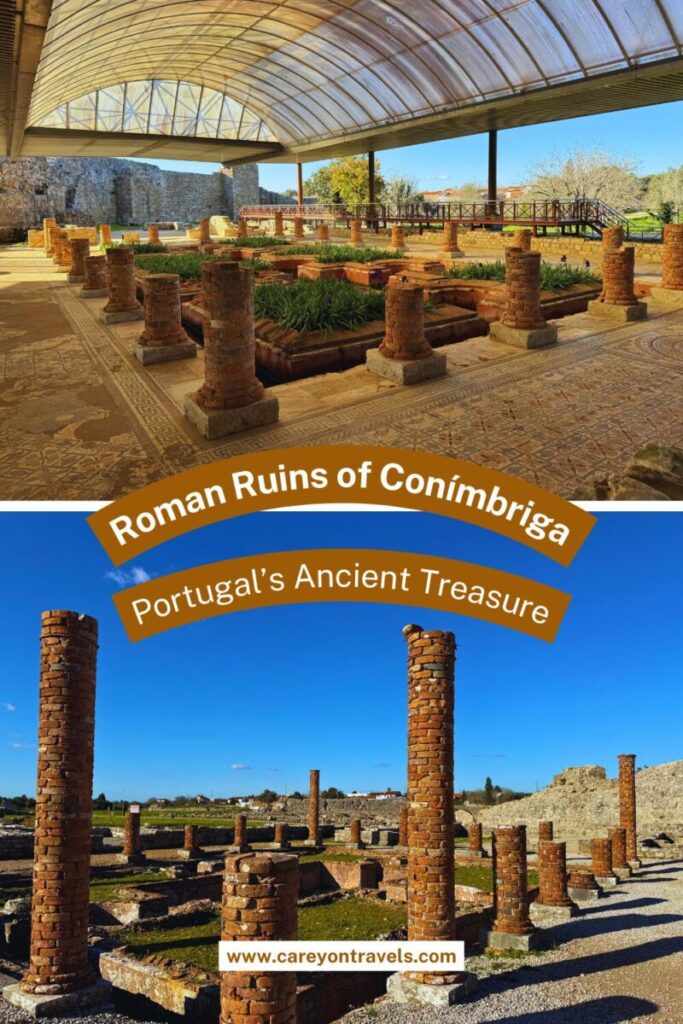
Travel Resources
We recommend booking through our preferred travel booking sites below.
| Air Travel | SkyScanner |
| Lodging | Booking.com, VRBO.com, Expedia.com, Hostelworld |
| Tours and Activities | Viator.com, GetYourGuide.com, TakeWalks.com |
| Car rentals | Discovercars.com |
| Travel insurance | Squaremouth |
| Bike and scooter rentals | BikeBookings.com |
| Train tickets | Trainline, RailEurope |
| Bus tickets | Flixbus, Busbud |

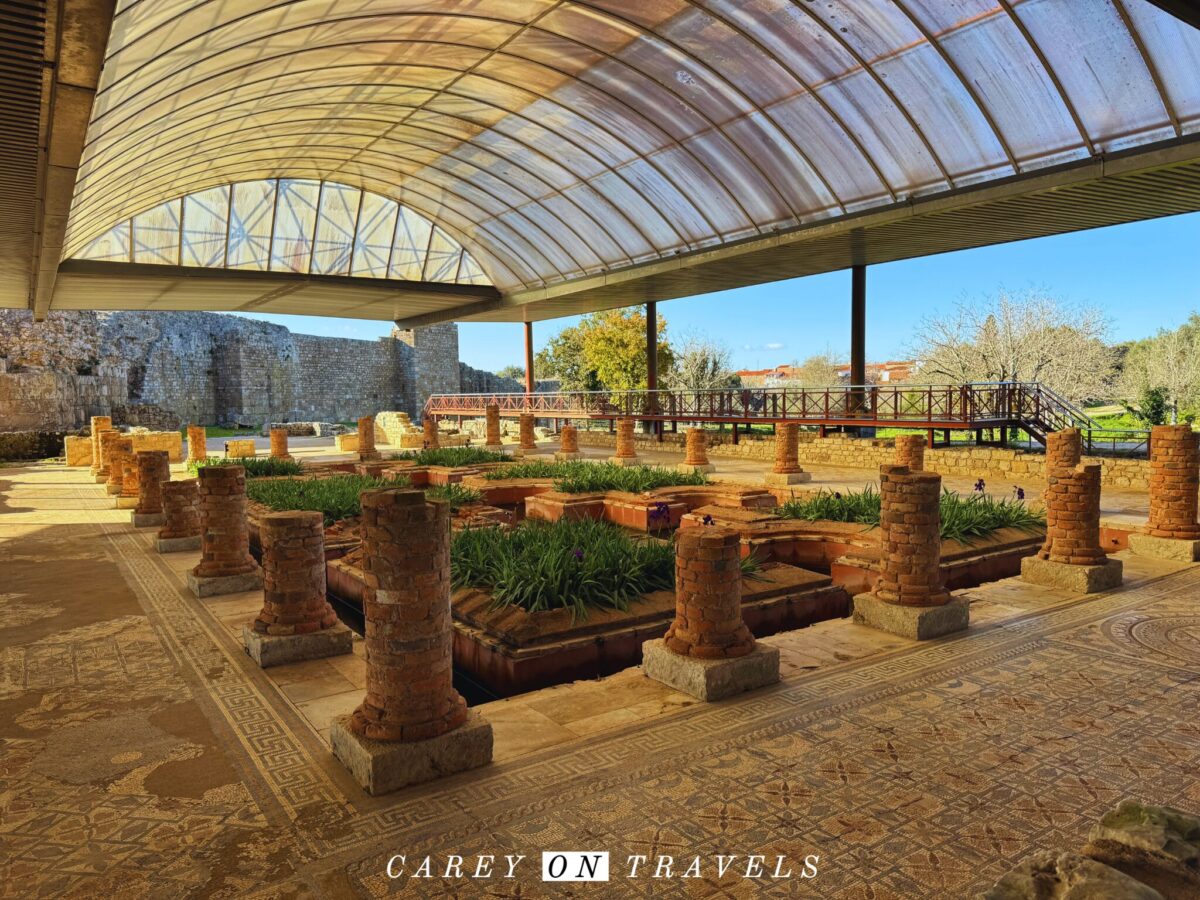

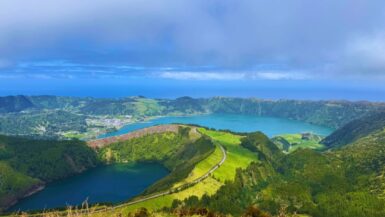

[…] Previous article The Best Cities in Portugal: Which One Should You Visit? Next article Conimbriga Roman Ruins Portugal Home » Blog » adventure » Portugal Schist Villages of Lousã Mountain, Day Trip from […]
Love the mosaics and Cantaber House
Thank you!
Had no idea there were Roman ruins in Portugal! I have been seeing a lot of great stuff about visiting Portugal recently and have been moving it further up on my bucket list.
Great! Hope you can visit.
I love history and I could easily spend all day here exploring the ruins. Portugal is truly fascinating without a shortage of things to do and see. I’ll be adding Conímbriga to my bucket list for sure!
I am a huge fan of ancient ruins! I wasn’t aware of these in Portugal. I will definitely have to visit!
There are quite a few in Portugal, but these are the most extensive ones in Portugal that we’ve visited to date.
I’ve been to Portugal several times but I´ve never heard of the Conimbriga Roman Ruins! It really is a great place to visit!
It’s not too hard to get to from Lisbon or Porto, though we’d suggest Coimbra as a base for visiting.
This is fascinating and not somewhere I’d heard of before – thanks for sharing!
This looks like my type of place. I would love to visit.
Hope you can visit.
Amazing! I’m going to Portugal soon and will add this to my list xx
Hope you have a chance to visit!
One of my regrets while visiting Portugal was that the Roman ruins closest to us were closed. I love to wander through history.
The 1st time I visited these ruins, the workers were on strike. But it re-opened the next day thankfully. I do know that some ruins (like Troia) are only open during the warmer months of the year, except to large groups.
[…] includes a 4-day itinerary covering the city’s must-visit landmarks along with nearby gems like Conimbriga’s Roman ruins, Lousã’s […]
How interesting! I really enjoyed visiting various ruins in Rome and Greece and always find that taking a tour adds so much value to these visits! I’d love to tour the Conimbriga Roman Ruins too – and, Portugal has been on my list for ages, so just another reason to visit soon :). Xx Sara
Tours definitely add value when there is so much historical information such as with ruins.